Abstract
Successfully replacing meat with plant-based options will require not only replicating the texture of muscular fibres, but also imitating the taste, aroma, and juiciness of meat as closely and realistically as possible. This study examines the impact of rapeseed oil on the textural properties of meat analogues. Pea protein and soy protein are chosen as model systems to assess the effect of rapeseed oil. Optical, mechanical, and rheological characterisation tests are conducted to investigate the oil droplet distribution, the gel strength, Young’s modulus, and the length of the LVE region. The hypothesis is that oil droplets will act as active fillers in the protein matrix, and thus, diminish the strength of the protein gel network. The results of this study show that rapeseed oil droplets act as inactive fillers, as they are not bound to both examined protein matrices. Soy protein extrudates display minimal changes, while pea protein extrudates are significantly affected by the addition of oil. For example, oil addition decreased the G′ in the LVE region of pea protein meat analogues by 50%, while soy protein samples showed no significant changes. Despite the similar interfacial activities of the investigated proteins, the decreased encapsulation efficiency of pea protein was confirmed by the higher amount of extracted oil from the respective extrudates.
1. Introduction
The global population is expected to reach the 10 billion mark by 2050. The necessity of feeding 10 billion people will generate threats to food security, nutrition, and sustainable, environmentally conscious development. The food industry is already responsible for 21–37% of the overall production of CO2, with meat products being the most critical source []. Meat production poses an inefficient use of land and freshwater and is responsible for deforestation and biodiversity loss []. In addressing the challenge of providing enough protein to a growing population while reducing the environmental impact of the food industry, the partial or complete substitution of animal proteins through plant proteins represents an encouraging solution [].
One alternative to meat is plant-based meat analogues, produced via high-moisture-extrusion cooking []. During this process, shear and thermal energy alter the raw plant proteins, and the result is an anisotropic, fibrous protein matrix that mimics the muscle structure of meat [,]. Whilst the exact mechanisms leading to fibre formation are still an object of research, there are two main models that aim to describe these phenomena []. One theory assumes a multiphase mixture, with both continuous and dispersed phases. The dispersed phase (fat, polysaccharides, proteins, water, or air) deforms and elongates due to thermo-mechanical stress. Subsequently, the dispersed phase solidifies in its elongated form, thus forming fibres []. However, Manski et al. (2007) [] showed that Ca-caseinate alone, without any dispersed phase, rearranges into fibres during shearing. The other theory supposes the presence of protein–protein interactions due to thermo-mechanical treatment during the extrusion process. It proposes that the proteins unfold because of energy input, allowing functional groups, such as hydrophobic and sulfhydryl groups, to become exposed []. The shear stress then causes the rearrangement and alignment of the now-denatured protein, forcing protein–protein interactions such as hydrophobic, hydrophilic, electrostatic, and disulphide bonding, the Maillard reaction, and isopeptide bonds [,,]. The cooling step inside the die solidifies the protein network, which results in a cross-linked protein gel with layered fibres. The degree of texturisation depends on process parameters, such as a temperature, shear, and pressure, as well as on formulation parameters, like protein functionality, water content, and interactions with other ingredients [,,].
Although extruded meat alternatives have been produced since the 1960s [] and the demand for such products continues to grow rapidly, many consumers still balk at the lack of resemblance to real meat. To meet consumers’ demands, new products need to be developed that mimic not only muscular fibres but also the taste, aroma, and juiciness of meat as authentically as possible [].
Therefore, the main technological challenge of today is to achieve texture, juiciness, organoleptic, and sensory perceptions comparable to those of animal products. Lipids are a key component of meat products and correlate to the consumer’s juiciness perception []. For this reason, to improve the texture and taste of plant-based meat analogues, oils and fats are usually added to the formulation. Though increasing the juiciness perception of the extrudates, oil and fats can also influence the extrusion process and the textural properties, such as fibre formation, of the final product []. The effect of fats and oils on the extrusion process has been widely investigated, especially in relation to expanded starch-based and low-moisture protein-based extrudates. Lipids act as plasticisers, as they decrease the viscosity of the melt and can lubricate the extruder. This may result in a decrease in shearing and friction, and consequently, in the dissipation of the mechanical energy input []. Due to this reduction in mechanical energy input, it is expected that the reaction behaviour of the proteins will also change, possibly leading to a less fibrous structure []. However, the degree of interference depends on the individual interactions between oil/fat and proteins, as the mechanisms involved in structure formation, oil stabilisation, and interaction amongst ingredients are distinct for every protein–oil combination. Precise predictions are difficult, as hardly any prior publications on the effect of oil on high-moisture meat analogues are available.
Some researchers have studied the effect of peanut oil, soybean oil, and rapeseed oil on the texture formation of wheat gluten [,]. Wheat gluten is a highly reactive protein that forms a 3D network mainly via covalent disulphide bond cross-links []. Jia et al. (2019) [] found that the addition of oil up to 8% of the overall mass enhanced the formation of cross-links. On the other hand, Kendler et al. (2021) [] showed that increasing the oil concentration reduced the rate of polymerisation of wheat gluten, even if the oil was added to the last port of the extruder. Therefore, it was concluded that the effect of oil on wheat gluten was caused by lubrication, and consequently, energy dissipation. The results presented by Kendler et al. apply to proteins that form an anisotropic structure via polymerisation.
Pea protein forms a protein network mainly over covalent disulphide bonds, in the same manner as wheat gluten []. The influence of oil on pea protein extrudates is described by Chen et al. (2022) [], and the results suggest that pea proteins react over covalent bonds. The alternative mechanism, whereby proteins coagulate and form non-covalent bonds, is not discussed. For soy protein, on the other hand, non-covalent bonds are primarily responsible for gelation [,]. Therefore, a direct transfer of results to soy protein from studies performed on covalently linked gels (like gluten or pea protein) might not be possible. Gwiazda et al. (1987) [] also observed a reduction in the fibre formation of soy-based extrudates when oil was added.
Although these results are a stepping stone in the research on protein–oil interactions in extrudate protein matrices, the presented studies focus on different proteins and draw conclusions from their own model systems and processing parameters. However, a comparison between proteins that react through different mechanisms is still missing. Moreover, each study has its own method for characterising the anisotropy of the product, either mechanically or rheologically, in extruder-like conditions. Only a few have assessed the oil encapsulation efficiency in the final product and possible interactions between oil and protein.
Lipid particles have a lubricating effect that correlates with a creamy mouthfeel []. However, for this effect to be achieved, the stabilisation of droplets of a certain size in the protein matrix is required. It is known that lipid particles can affect the mechanical properties of protein matrices, which consequently affect the organoleptic perception of the final product [,]. Whether the lipids improve or worsen gel properties depends on interactions between the matrix and the surface of the droplet [,]. Particles that are not bound to a protein gel—also known as inactive fillers—cause loss of gel strength and increase the occurrence of syneresis. In contrast, gels with bound particles (active fillers) show significantly higher mechanical stability. Wiedemann et al. (2018) [] and Saavedra Isusi et al. (2022) [] have shown that fat particles affect the water-binding capacity, lubricating properties, and strength of the protein gel, depending on their interactions with protein matrices. If the aim of adding oil to plant-based meat alternatives is to meet consumer demand, a thorough investigation in this regard should be considered.
For this reason, this study addresses the application of mechanical and rheological characterisation as an approach to gaining insight into formulation and process parameters, facilitate product innovation, and assure an objective evaluation of the resulting product. To assess the effect of oil on the textural properties of meat substitutes, a covalent crosslinking protein and a non-covalent crosslinking protein were chosen as model systems: pea protein and soy protein, respectively. This study aims to show how parameters such as oil concentration and protein source define fibre formation. The influence of these parameters on product structure were evaluated using electron microscopy and image analysis. To assess mouthfeel, rheological measurements and texture analysis were performed as quantitative measures to compare meat analogues’ product properties.
2. Materials and Methods
2.1. Materials
Commercially available soy protein concentrate (SPC) (Alpha® 8, Solae, St. Louis, MO, USA, pea protein isolate (PPI) (Nutralys® F85F, Roquette, Lestrem, France), and rapeseed oil were used for this work. The protein content of SPC was >67% and of PPI was >84%, according to the manufacturers. n-Hexane, with a purity of at least 95%, was bought from Carl Roth (Karlsruhe, Germany).
2.2. Extrusion Process
Meat analogue products were produced with a fully ported Process 16 Hygienic Twin-Screw Extruder and a cooled slit die (Thermo Fisher Scientific, Karlsruhe, Germany). For easier dosing and quicker changes between different formulations, the three components were fed into the extruder separately. Either soy protein concentrate or pea protein isolate powder was fed into the extruder with a gravimetric Twin-Screw Feeder DDRS 20. Two peristaltic pumps were used for water and rapeseed oil feeding, respectively. Both water and oil feeding occurred in the third port of the extruder. The schematic process setup is shown in Figure 1. The dimensions of the cooled slit die were H × W × L: 6 × 28 × 375 mm.
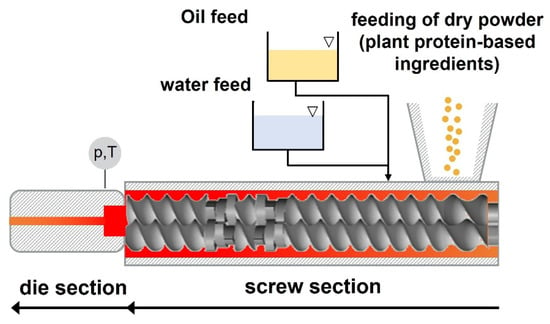
Figure 1.
Schematic extruder setup.
Three oil-containing formulations and one reference formulation without the addition of oil were analysed to investigate the influence of rapeseed oil on the characteristics of soy- and pea-based meat analogues. The amount (mass) of added oil was subtracted in equal parts from the protein and water content to maintain a constant protein-to-water ratio. An overview of all the formulations is presented in Table 1.

Table 1.
Overview of sample formulations.
The trials were performed under otherwise constant process parameter settings, where screw speed was kept at 400 rpm and total feed rate at 2 kg/h. The material temperature of the melt was measured at the extruder exit (before entering the cooling die) and verified to be 100 °C for all PPI formulations and 134 °C for all SPC ones. The temperature of the cooled slit die was kept constant at 50 °C. After the extrusion trials, samples were taken and stored at 5 °C in plastic bags to prevent drying and spoilage of the samples. Samples were analysed within two days after production.
2.3. Mechanical Measurements
The Young’s modulus, fracture stress, and fracture strain of the investigated samples were determined under compressive stress. For this purpose, gels were subjected to stress using a stress-controlled HAAKE MARS 60 rheometer (Thermo Fisher Scientific, Karlsruhe, Germany), and a stress–strain diagram was recorded. The Young’s modulus was calculated from the linear region of the stress–strain diagram using Equation (1) as described by Willats et al. (2001) and Fraeye et al. (2010) [,].
where
- E = Young’s modulus;
- F = measured force;
- A = probe’s cross-sectional area;
- ε = strain;
- ε was calculated as shown in Equation (2).
- Δl = change in the height of the sample caused by the applied stress;
- l0 = samples’ initial height.
Cylindrical-shaped extrudates with a 6 mm diameter and 5 mm height were cut for the determination of Young’s modulus under compression stress. Samples were compressed using a serrated plate–plate measurement system with a plate diameter of 20 mm at a constant velocity of 1 mm⋅s−1. The measurements were conducted 10 times for each sample to ensure statistical relevance.
2.4. Rheological Measurements
All rheological analyses were conducted using a stress-controlled HAAKETM MARSTM 60 rheometer (Thermo Fisher Scientific, Karlsruhe, Germany). These were performed using a serrated plate–plate measurement system with a plate diameter of 20 mm (P20/Ti/SE). The gap width was set to 5 mm for all samples. Amplitude sweeps were performed at a frequency of f = 1 Hz over a range of deformation from 0.00001 to 1. The deformation was increased logarithmically, and 20 measurement points were taken for each decade. All amplitude sweeps were conducted in triplicate for each sample at 20 °C. Before each measurement, all samples were allowed to sit 120 s to rest and equilibrate.
2.5. Visual Inspection
Sample preparation was conducted so as to permit visual inspection of the inner fibrous structure of the samples. For this, samples were pre-cut to predetermine a breaking point. Cuts were set lengthwise in the flow direction (indicated in the pictures by an arrow). After breaking up the sample at this point, the characteristic fibrous structure of the individual sample became visible.
2.6. Scanning Electron Microscopy
The analysis of the microstructure of the extruded samples was carried out using a Thermo ScientificTM PhenomTM XL G2 Desktop SEM. Samples were cut along the flow axis in order to expose a fracture surface along the middle axis of the sample. A piece of sample was fixed onto an aluminium SEM stub using carbon tape, and then, allowed to air dry. Lastly, the sample was fixed with copper–nickel tape to increase electron conductivity. The SEM analysis was carried out in high-vacuum mode using an Everhart–Thornley Detector (ETD) to collect secondary electron images, which provide topographic information. An acceleration voltage of 5 keV was selected to reveal enhanced surface details.
2.7. Encapsulation Efficiency
The amount of unencapsulated oil was determined using a solvent extraction method described by Tan et al. (2005) [], modified for application on extrusion samples. A total of 20 mL of n-hexane (Carl Roth GmbH + Co. KG, Karlsruhe, Germany) was added to samples with masses of around 5 g each in a 100 mL conical flask. The surface oil extraction was performed while shaking at 200 rpm for 2 min. The sample was subsequently removed from the flask, and the n-hexane was fully evaporated under a fume hood. After determination of the removed surface oil, the encapsulation efficiency was calculated using the following Equation (1):
where
- = total oil mass in the sample
- = mass of the extracted surface oil
The total oil mass in the sample was calculated assuming a homogeneous distribution of the oil throughout the sample. Encapsulation efficiency analyses were performed in triplicate.
2.8. Interfacial Tension
The interfacial activity of the investigated proteins at the oil–water interface was measured using an optical contact angle measuring and contour analysis system OCA 25 (DataPhysics Instruments GmbH, Filderstadt, Germany). Protein solutions with 1 wt% of protein dissolved in purified water (resistivity of 18.2 MΩ) were prepared at least 2 h before the measurements were taken. The pH of the solutions was not adjusted. A droplet of protein solution with a volume of 10 μL was formed at the tip of the tensiometer capillary, with the tip submerged in rapeseed oil at 25 °C. The interfacial tension was measured for 20 min. The interfacial tension at the water/rapeseed oil interface was also determined as a reference value. The measurements were conducted in triplicate.
2.9. Statistical Analysis
If not specified otherwise, all analyses were conducted at least three times per independent test. All data was assessed via multifactorial analysis of variance (ANOVA) and a Tukey test as a post hoc test. Dissimilarities in the samples were considered statistically relevant at a level of p ≤ 0.05. The software OriginPro 2019 (OriginLab Corp., Northampton, MA, USA) was used for the statistical analysis, calculation of averages, and standard deviations.
3. Results and Discussion
3.1. Effect of Oil on Macroscopic and Microscopic Structure
At first, we assessed the optical appearance of the investigated samples directly after production. For this, photographs of all samples were taken. Images of these samples can be found in Figure 2, with soy protein extrudates on the left and pea protein extrudates on the right.
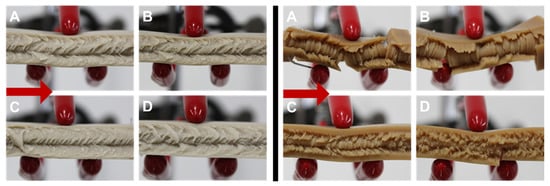
Figure 2.
Left: Soy protein extrudates with 0% (A), 2% (B), 4% (C), and 6% (D) added rapeseed oil. Right: Pea protein extrudates with 0% (A), 2% (B), 4% (C), and 6% (D) added rapeseed oil. Flow direction inside of the cooling die from left to right.
All the investigated formulations show fibrous, anisotropic structuring. The soy protein samples display a parabolic flow profile, whilst pea protein samples have a transversal fibre formation in relation to the flow direction of the melt inside the die. The differences in the fibre formation between the two investigated proteins could be caused by differences in the melt temperature, melt viscosity and reaction behaviour, amongst other factors [,]. However, such effects are not within the scope of this study.
For both proteins, there is a clear visual difference in the structure when oil is added, with sample fibrosity decreasing with the oil content. Pea protein samples containing the smallest amount of oil show little-to-slight differences in their anisotropic structure. For samples made with this protein type, one can also observe that the fibres lose clear contours with increasing oil concentration. At the highest oil concentration investigated, the pea protein sample changes to a dough-like, mushy texture. For soy protein samples, the effect of oil addition on the optical appearance is less pronounced. For the samples made with no and small oil concentrations, the degree of fibrosity seems comparable. Even with further increasing oil concentration, there is still a distinct separation between the fibres in the soy protein samples.
In order to look more closely at the microscopic structure of all samples, micrographs were taken. All samples were observed using a scanning electron microscope, with prior preparation as described above. The obtained micrographs are depicted in Figure 3 for soy protein extrudates and Figure 4 for pea protein extrudates.
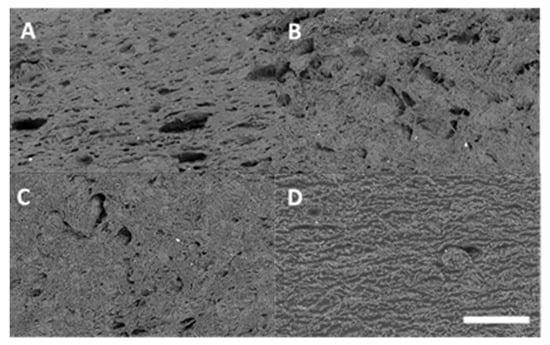
Figure 3.
Scanning electron micrographs of soy protein extrudates with 0% (A), 2% (B), 4% (C), and 6% (D) added rapeseed oil. Bar equals 300 µm.
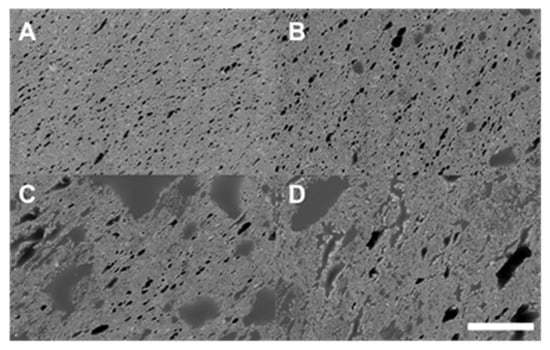
Figure 4.
Scanning electron micrographs of pea protein extrudates with 0% (A), 2% (B), 4% (C), and 6% (D) added rapeseed oil. Bar equals 300 µm.
The electron microscope images also show that there is a clear difference between the two investigated protein types. The protein matrix appears in light grey, the oil in darker grey, and the pores filled with air in black. Whereas the soy protein micrographs display a clean, porous structure for all samples, the pea protein samples display oil “lagoons” on their surfaces. These lagoons are an indicator of oil droplet coalescence during the extrusion process, possibly signifying that the emulsifying properties of the investigated pea protein are not as effective in droplet stabilisation compared to soy protein. As a result, the added oil is found in larger droplets inside and on the surface of the samples. Contrary to this, soy protein samples do not display these large droplets. This could be attributed to better emulsifying properties of the protein and even to the influence of the polysaccharides found in the concentrate. The encapsulation efficiency depends, among other factors, on the interfacial adsorption and film formation of the emulsifying agent of the formulation []. Therefore, the interfacial tension between proteins in solution and rapeseed oil was determined via pendant drop tensiometry. For both proteins, the equilibrium values are around 10 mN⋅m−1, which is significantly lower than the interfacial tension value for pure water (without any emulsifying agents or interfacial active substances) and rapeseed oil (27 mN⋅m−1). Therefore, both proteins’ functional groups adsorb []. While the decrease in interfacial tension shows the adsorption of the proteins, it cannot lead to any conclusions on the effectiveness of stabilisation of the protein film.
It must be kept in mind that the measuring conditions do not represent extrusion conditions, where the protein–oil matrix is subjected to high temperatures over very short times. The emulsifying and encapsulation properties are affected by the temperature and viscosity []. Therefore, it can be assumed that the high temperature of the extrusion process affects the pea protein’s emulsifying properties to a greater degree than it does those of soy protein. Additionally, droplet stabilisation depends highly on the unfolding of proteins and the attachment of functional groups to the droplet’s surface. Considering that droplet stabilisation and protein–protein interaction are different mechanisms competing for the same functional groups, it can be hypothesised that protein interactions between pea proteins supersede the stabilisation of oil droplets. Nevertheless, this assumption cannot be corroborated, as it still remains unclear which functional groups are responsible for droplet stabilisation or for fibre formation.
As seen in the figures above, there is a clear influence of oil on the anisotropic structure of the samples, which is highly dependent on protein type. This could be due to the difference in the oil encapsulation properties of the protein. However, the effect is yet to be evaluated in a quantitative manner. For this reason, the samples’ mechanical properties were analysed.
3.2. Influence of Oil on the Rheological and Mechanical Properties of Meat Analogues
In this study, extruded meat analogues are viewed as highly concentrated protein gels (hereafter also referred to as continuous phase or matrix) with a fibrous structure and an oil dispersed phase. Therefore, for better understanding of the influence of oil on the texture of extrudates, all underlaying hypotheses of this work are based on the existing theories of protein gels, regardless of the processing technique. Based on the literature focused on food protein gels, the mechanical properties of these materials are strongly affected by the protein matrix, the volume fraction and droplet size of the dispersed phase, and the interactions between the continuous and dispersed phases [,,]. As previously stated, droplets can act as either active or inactive filler depending on particular interactions [], and thus, can affect the gel strength. For this reason, the rheological properties of extrudates, such as deformability, viscosity, and relaxation, are key to understanding the interaction between oil and protein. The deformability of the samples can be assessed from the linear viscoelastic (LVE) region of the material. Soft, elastic matter will deform and sustain greater strain stress than harder or brittle materials []. Therefore, the maximal stress within the linear viscoelastic region is determined by the deformability of gels. The length of the LVE regime indicates whether the protein matrix is strong or weak []. Amplitude tests were conducted on all samples. The obtained amplitude tests are found in Figure 5 and Figure 6 for soy protein and for pea protein, respectively.
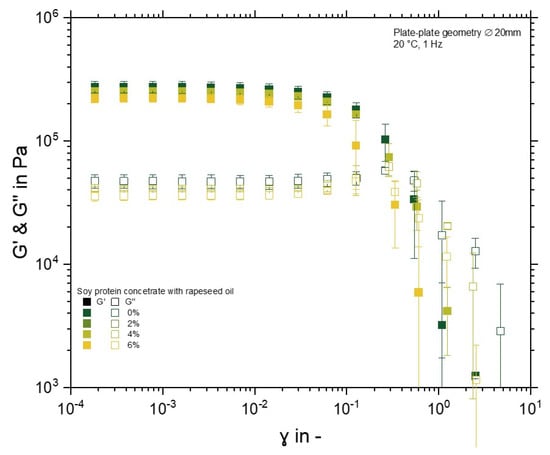
Figure 5.
Amplitude test of soy protein extrudates, with 0%, 2%, 4%, and 6% added rapeseed oil. Tests conducted at frequency of 1 Hz and at 20 °C with a plate–plate geometry.
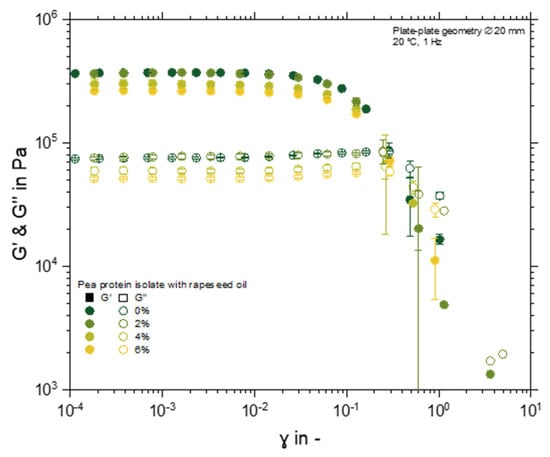
Figure 6.
Amplitude test of pea protein extrudates, with 0%, 2%, 4%, and 6% added rapeseed oil. Tests conducted at frequency of 1 Hz and at 20 °C with a plate–plate geometry.
All samples exhibited predominantly elastic behaviour, as G′ was greater than G″, and thus, the samples can be regarded as solid-like material. There are some differences between the two investigated proteins. Pea protein meat analogues without additional oil have a higher plateau value of G′ (3.96 0.08 × 105 Pa) than comparable meat analogues with soy protein (2.77 0.23 × 105 Pa). As the crosslinking density of gels can be estimated from the storage modulus G′ [], one could assume that pea protein extrudates have a denser crosslinked network. Moreover, there differences in the viscous properties of the gels are also noticeable in both figures, as G″ values differ between both proteins. These may arise from differences in the gel structure, which result in different energy dissipation ratios []. Pore size, network inhomogeneity, and oil droplets may be responsible for this. As can be seen in the figures, soy protein extrudates possess the lowest values for G″, which results in lower energy dissipation throughout the polymer network. This can be attributed to a more homogeneous protein network, which is also noticeable from the micrographs taken. Furthermore, the investigated samples possess LVE regions of similar length for both soy protein and pea protein samples. However, contrary to expectation, the addition of rapeseed had little effect on the LVE and the maximal deformation of the samples.
On the one hand, it was assumed that the addition of oil droplets would affect the length of the LVE and the storage modulus G′ of the soy protein extrudates by increasing the gel strength [,]. Due to the homogeneity of the soy samples and the lack of coalesced droplets, it was assumed that the oil droplets were integrated into the protein network as active fillers. However, as seen in Figure 5, amplitude tests show no significant difference in G′ and the crossover point of all soy protein samples at the p > 0.05 level. Ningtyas et al. (2021) [] showed that the effect of oil and/or fat depends both on the type of oil/fat that is incorporated into the soy matrix and on the amount of the dispersed phase. Significant changes in gel firmness have been observed for oil concentrations over 10% []. Thus, the lack of significant changes could be attributed to the low concentration of rapeseed oil.
On the other hand, there is a slight but noticeable difference in the measured amplitude tests of pea protein samples. The value of the storage modulus in the LVE region decreases with the addition of rapeseed oil, ranging from 3.96 0.08 × 105 Pa for 0% to 4.02 0.2 × 105 Pa for 2%, 3.12 0.2 × 105 Pa for 4% and 2.3 0.1 × 105 Pa for 6% added oil samples.
Samples with 4% and 6% added oil are significantly different from each other and from the other pea protein formulations. Thus, it can be assumed that the crosslinking density of the pea protein matrix decreases due to the addition of oil. Differences in the viscous properties of the gels are also noticeable in Figure 6, as the G″ values differ. These may arise from differences in the gel structure, which result in different energy dissipation ratios []. Kendler et al. (2021) [] showed that the addition of oil during the extrusion process of wheat gluten reduced the degree of polymerisation, which resulted in weaker protein matrices. Based on these results, it can be assumed that oil has a similar effect on pea protein extrudates because both pea protein and wheat gluten polymerise mainly through disulphide bonds [,]. Additionally, recent studies conducted by Chen et al. (2022) [] showed, for pea protein meat analogues, that the presence of fatty acids prevented the aggregation of legumin and vicilin, demonstrating a negative consequence in the anisotropic structure of the extrudates. Thus, the rheological results presented in this study are in good agreement with previous studies.
However, previous studies based their conclusions on the mechanical characterisation of the samples [,]. To prove that the rheological data presented in this study are also a valuable tool for sample characterisation, additional mechanical characterisation was conducted to validate the rheological data. For this, compression tests were performed on all investigated formulations. The obtained stress–strain diagrams are found in Figure 7 for soy protein samples and in Figure 8 for pea protein samples. Additionally, the compression module was calculated from the elastic region of each curve and was plotted against the oil concentration (Figure 9).
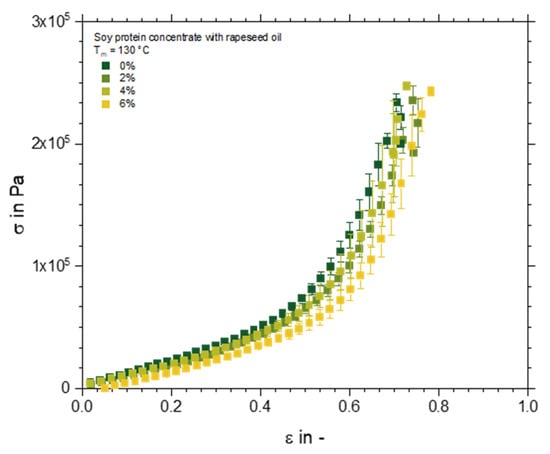
Figure 7.
Compression test of soy protein extrudates, with 0%, 2%, 4%, and 6% added rapeseed oil.
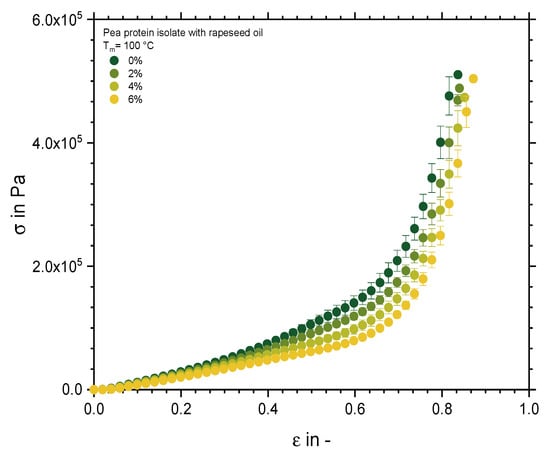
Figure 8.
Compression test of pea protein extrudates, with 0%, 2%, 4%, and 6% added rapeseed oil.
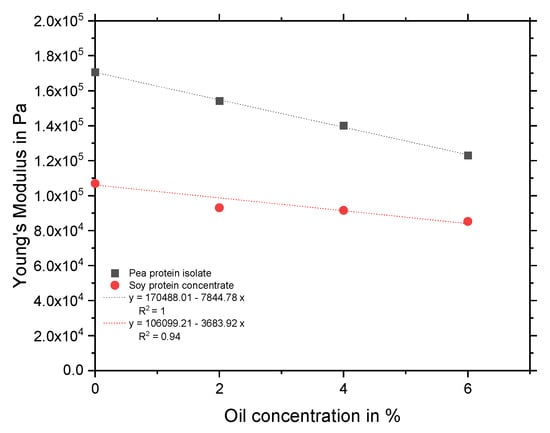
Figure 9.
Young’s moduli of pea and soy protein extrudates, with 0%, 2%, 4%, and 6% added rapeseed oil over the oil concentration.
The results depicted in Figure 8 and Figure 9 show that soy protein extrudates possess a lower value for maximal strain and stress compared to pea protein samples. Thus, under compressive stress, soy protein extrudates would break readily, whilst pea protein extrudates would require a higher mechanical energy input. This affirms the tendency already illustrated by the rheological data. Nevertheless, the influence of oil on both protein types is more pronounced when straining the samples under compressive stress. During compression, part of the energy is stored in the matrix and part of it is dissipated []. Energy dissipation will cause fractures in the fragile regions within the matrix. Particles can act as structural inhomogeneities that can focus the stress, thus acting as structure breakers or breaking points. In turn, this leads to decreased fracture strain and decreased fracture stress []. However, this is not the case for the investigated samples. Both figures show a clear shift towards higher values in the maximum strain of the samples with increasing oil content. This could possibly be due to the plasticising effect of oil on both soy and pea protein matrices.
Although the plasticising effect of oil is visible for both protein types, it remains unclear whether the oil droplets participate in the gel formation or act as inactive fillers. Many authors have shown that an increase in the elastic modulus (E) is caused by an increase in molecular rigidity [], which, for protein extrudates could be a consequence of a high number of cross-links []. As seen in Figure 9, E decreases with the addition of oil. The regression curves depicted in Figure 9 have a negative slope for both protein types. Nonetheless, the negative effect of oil on gel firmness is greater for pea protein samples, as already confirmed by the previously presented results. These results seem to contradict earlier studies on protein gels with unbound fat particles protein []. The authors found that the small deformations under compression within the elastic region deform only the intermediate aqueous layer between the droplets and protein matrix [,]. In the results discussed here, it can be assumed that the aqueous layer creates structural defects, decreasing the elasticity of the samples.
Taking into account the results discussed in this section and the optical assessment of the samples, it can be concluded that rapeseed oil droplets do not interact with either investigated protein type. Even though both proteins showed great interfacial activity, droplets are neither embedded into the matrix nor do they strengthen it. Therefore, it can be hypothesised that the extrusion process reduces the interactions between proteins and oil due to thermo-mechanical treatment of the protein and the reduction in available functional groups caused by an ongoing polymerisation process.
3.3. Encapsulation Efficiency
Apart from the oil droplets that are embedded within the protein matrix, some of the oil can also be on the surface of the meat analogues. This surface oil changes both the friction in the extrusion barrel and the first oral perception when the product is consumed. Depending on the different interactions of the two protein sources with oil, different encapsulation values are to be expected. The amount of extractable oil from the product surface is depicted in Figure 10.
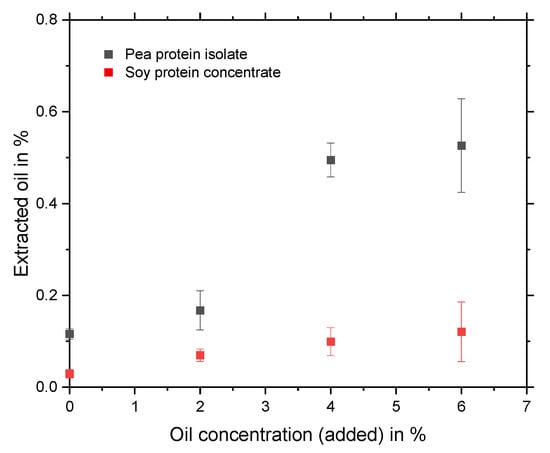
Figure 10.
Encapsulation efficiency of pea and soy protein extrudates, with 0%, 2%, 4%, and 6% added rapeseed oil over the oil concentration.
As seen from Figure 10, the encapsulation efficiency differs strongly amongst the investigated samples. Whereas soy protein meat analogues retain oil droplets inside the matrix, showing only a slight decrease in encapsulation with increasing oil concentration, pea protein samples have higher amounts of surface oil. This is a clear indication that the oil droplets are not well embedded in the pea protein matrix and are easily accessible for solvent extraction. To prove this assumption, measurements of the friction coefficient of the extrudates’ surface could be useful. Overall, the results discussed in this section confirm the results of the mechanical characterisation of the samples and are in good agreement with the underlying hypothesis of the work.
4. Conclusions
In this study, the effects of rapeseed oil on the textural properties of meat analogues were assessed. It was found that for both protein types, rapeseed oil droplets act as an inactive filler, as they are not bound to the protein matrix. It was shown that key mechanical and rheological properties, such as gel strength, Young’s modulus, and the length of the LVE region, were decreased by the presence of oil. Nevertheless, the effect on the protein matrix differed depending on the protein type. Whereas soy protein extrudates displayed minimal changes, the mechanical and rheological properties of pea protein extrudates were strongly affected by the addition of oil. Even though the investigated proteins possessed similar interfacial activities, decreased encapsulation efficiency of pea protein could be confirmed by the higher amount of extracted oil from the respective extrudates. This study addressed the application of mechanical and rheological characterisations as an approach to gaining insight into formulation and process parameters, with the aim of evaluating the resulting product and displaying key differences in the most commonly used plant proteins for meat analogues.
Author Contributions
G.I.S.I.: conceptualisation, methodology, validation, formal analysis, project administration, investigation, writing—original draft, and visualisation. V.P.: validation, formal analysis, methodology, investigation, and writing—review and editing. P.B.: validation, formal analysis, and investigation. S.H.: validation, investigation, and visualisation. N.L.: validation, formal analysis, methodology, investigation, visualisation, and writing—review and editing. All authors have read and agreed to the published version of the manuscript.
Funding
This research received no external funding.
Data Availability Statement
The data presented in this study are available on request from the corresponding author.
Conflicts of Interest
The authors declare no conflict of interest.
References
- FAO; IFAD; UNICEF; WFP; WHO. The State of Food Security and Nutrition in the World 2020; FAO: Rome, Italy, 2020. [Google Scholar]
- Djekic, I. Environmental Impact of Meat Industry—Current Status and Future Perspectives. Procedia Food Sci. 2015, 5, 61–64. [Google Scholar] [CrossRef]
- Smil, V. Feeding the World: A Challenge for the Twenty-First Century; MIT Press: Cambrige, MA, USA, 2000. [Google Scholar]
- Cheftel, J.C.; Kitagawa, M.; Quéguiner, C. New protein texturization processes by extrusion cooking at high moisture levels. Food Rev. Int. 1992, 8, 235–275. [Google Scholar] [CrossRef]
- Tolstoguzov, V.B. Thermoplastic extrusion-the mechanism of the formation of extrudate structure and properties. J. Am. Oil Chem. Soc. 1993, 70, 414–424. [Google Scholar] [CrossRef]
- Beniwal, A.S.; Singh, J.; Kaur, L.; Hardacre, A.; Singh, H. Meat analogs: Protein restructuring during thermomechanical processing. Compr. Rev. Food Sci. Food Saf. 2021, 20, 1221–1249. [Google Scholar] [CrossRef]
- Manski, J.M.; van der Goot, A.J.; Boom, R.M. Formation of Fibrous Materials from Dense Calcium Caseinate Dispersions. Biomacromolecules 2007, 8, 1271–1279. [Google Scholar] [CrossRef]
- Dijkstra, M.J.J.; Fokkink, W.J.; Heringa, E.; van Dijk, E.; Abeln, S. The characteristics of molten globule states and folding pathways strongly depend on the sequence of a protein. Mol. Phys. 2018, 116, 3173–3180. [Google Scholar] [CrossRef]
- Fang, Y.; Zhang, B.; Wei, Y. Effects of the specific mechanical energy on the physicochemical properties of texturized soy protein during high-moisture extrusion cooking. J. Food Eng. 2014, 121, 32–38. [Google Scholar] [CrossRef]
- Pietsch, V.L.; Emin, M.A.; Schuchmann, H.P. Process conditions influencing wheat gluten Process conditions influencing wheat gluten extrusion of meat analog products. J. Food Eng. 2017, 198, 28–38. [Google Scholar] [CrossRef]
- Osen, R.; Toelstede, S.; Wild, F.; Eisner, P.; Schweiggert-Weisz, U. High Moisture extrusion cooking of pea protein isolates: Raw material characteristics, extruder responses, and texture properties. J. Food Eng. 2014, 127, 67–74. [Google Scholar] [CrossRef]
- Wittek, P.; Zeiler, N.; Karbstein, H.P.; Emin, M.A. High Moisture Extrusion of Soy Protein: Investigations on the Formation of Anisotropic Product Structure. Foods 2021, 10, 102. [Google Scholar] [CrossRef]
- Chen, F.L.; Wei, Y.M.; Zhang, B.; Ojokoh, A.O. System parameters and product properties response of soybean protein extruded at wide moisture range. J. Food Eng. 2010, 96, 208–213. [Google Scholar] [CrossRef]
- Guy, R. Extrusion Cooking: Technologies and Applications; Woodhead Publishing: Cambridge, UK, 2001. [Google Scholar]
- Hoek, A.C.; Luning, P.A.; Weijzen, P.; Engels, W.; Kok, F.J.; de Graaf, C. Replacement of meat by meat substitutes. A survey on person- and product-related factors in consumer acceptance. Appetite 2011, 56, 662–673. [Google Scholar] [CrossRef] [PubMed]
- Huang, X.; Ahn, D.U. Lipid oxidation and its implications to meat quality and human health. Food Sci. Biotechnol. 2019, 28, 1275–1285. [Google Scholar] [CrossRef] [PubMed]
- Zhang, X.; Zhao, Y.; Zhao, X.; Sun, P.; Zhao, D.; Jiang, L.; Sui, X. The texture of plant protein-based meat analogs by high moisture extrusion: A review. J. Texture Stud. 2022, 54, 351–364. [Google Scholar] [CrossRef]
- Ilo, S.; Schoenlecher, R.; Berghofe, E. Role of lipids in the extrusion cooking processes. Grasas Y Aceites 2000, 51, 97–110. [Google Scholar] [CrossRef]
- Opaluwa, C.; Lott, T.; Karbstein, H.P.; Emin, M.A. Encapsulation of oil in the high moisture extrusion of wheat gluten: Interrelation between process parameters, matrix viscosity and oil droplet size. Future Foods 2023, 7, 100222. [Google Scholar] [CrossRef]
- Chen, Y.; Liang, Y.; Jia, F.; Chen, D.; Zhang, X.; Wang, Q.; Wang, J. Effect of extrusion temperature on the protein aggregation of wheat gluten with the addition of peanut oil during extrusion. Int. J. Biol. Macromol. 2021, 166, 1377–1386. [Google Scholar] [CrossRef]
- Jia, F.; Wang, J.; Chen, Y.; Zhang, X.; Wang, Q.; Chen, D.; Zhang, C. Effect of oil contents on gluten network during the extrusion processing. Czech J. Food Sci. 2019, 37, 226–231. [Google Scholar] [CrossRef]
- Kendler, C.; Duchardt, A.; Karbstein, H.P.; Emin, M.A. Effect of Oil Content and Oil Addition Point on the Extrusion Processing of Wheat Gluten-Based Meat Analogues. Foods 2021, 10, 697. [Google Scholar] [CrossRef]
- Chen, Q.; Zhang, J.; Zhang, Y.; Wang, Q. Effect of fatty acid saturation degree on the rheological properties of pea protein and its high-moisture extruded product quality. Food Chem. 2022, 390, 133139. [Google Scholar] [CrossRef]
- Liu, K.; Stieger, M.; van der Linden, E.; van de Velde, F. Fat droplet characteristics affect rheological, tribological and sensory properties of food gels. Food Hydrocoll. 2015, 44, 244–259. [Google Scholar] [CrossRef]
- Pietsch, V.L.; Bühler, J.M.; Karbstein, H.P.; Emin, M.A. High moisture extrusion of soy protein concentrate: Influence of thermomechanical treatment on protein-protein interactions and rheological properties. J. Food Eng. 2019, 251, 11–18. [Google Scholar] [CrossRef]
- Gwiazda, S.; Noguchi, A.; Saio, K. Microstructural Studies of Texturized Vegetable Protein Products: Effects of Oil Addition and Transformation of Raw Materials in Various Sections of a Twin Screw Extruder. Food Struct. 1987, 6, 57–61. [Google Scholar]
- Malone, M.E.; Appelqvist, I.A.M.; Norton, I.T. Oral behaviour of food hydrocolloids and emulsions. Part 1. Lubrication and deposition considerations. Food Hydrocoll. 2003, 17, 763–773. [Google Scholar] [CrossRef]
- Daget, N.; Joerg, M.; Bourne, M. Creamy Perception I: In model dessert creams. J. Texture Stud. 1987, 18, 367–388. [Google Scholar] [CrossRef]
- Chen, J.; Dickinson, E. Viscoelastic Properties of Heat-Set Whey Protein Emulsion Gels. J. Texture Stud. 1998, 29, 285–304. [Google Scholar] [CrossRef]
- Chen, J.; Dickinson, E. Viscoelastic Properties of Protein-Stabilized Emulsions: Effect of Protein-Surfactant Interactions. J. Agric. Food Chem. 1998, 46, 91–97. [Google Scholar] [CrossRef]
- Wiedenmann, V.; Oehlkea, K.; van der Schaaf, U.; Hetzera, B.; Greinera, R. Impact of the incorporation of solid lipid nanoparticles on β-lactoglobulin gel matrices. Food Hydrocoll. 2018, 84, 498–507. [Google Scholar] [CrossRef]
- Saavedra Isusi, G.I.; Paz Puga, D.; van der Schaaf, U. Texturing Fermented Emulsion Gels from Soy Protein: Influence of the Emulsifying Agent—Soy Protein vs. Pectin Microgels—On Gel Microstructure, Rheology and Tribology. Foods 2022, 11, 294. [Google Scholar] [CrossRef]
- Willats, W.G.; Orfila, C.; Limberg, G.; Buchholt, H.C.; van Alebeek, G.J.W.M.; Voragen, A.G.; Marcus, S.E.; Christensen, T.M.I.E.; Mikkelsen, J.D.; Murray, B.S.; et al. Modulation of the degree and pattern of methyl-esterification of pectic homogalacturonan in plant cell walls. Implications for pectin methyl esterase action, matrix properties and cell adhesion. J. Biol. Chem. 2001, 276, 19404–19413. [Google Scholar] [CrossRef]
- Fraeye, I.; Colle, I.; Vandevenne, E.; Duvetter, T.; van Buggenhout, S.; Moldenaers, P.; van Loey, A.; Hendrickx, M. Influence of pectin structure on texture of pectin-calcium gels. Innov. Food Sci. Emerg. Technol. 2010, 11, 401–409. [Google Scholar] [CrossRef]
- Tan, L.H.; Chan, L.W.; Heng, P.W.S. Effect of oil loading on microspheres produced by spray drying. J. Microencapsul. 2005, 22, 253–259. [Google Scholar] [CrossRef] [PubMed]
- Bouvier, J.M.; Campanella, O. Extrusion Processing Technology: Food and Non-Food Biomaterials; John Wiley & Sons Inc.: Chichester, UK, 2014. [Google Scholar]
- Ravera, F.; Dziza, K.; Santini, E.; Cristofolini, L.; Liggieri, L. Emulsification and emulsion stability: The role of the interfacial properties. Adv. Colloid Interface Sci. 2021, 288, 102344. [Google Scholar] [CrossRef]
- McClements, D.J. Protein-stabilized emulsion. Curr. Opin. Colloid Interface Sci. 2004, 9, 305–313. [Google Scholar] [CrossRef]
- Van Vliet, T. Rheological properties of filled gels. Influence of filler matrix interaction. Colloid Polym. Sci. 1988, 266, 518–524. [Google Scholar] [CrossRef]
- Adams, S.; Frith, W.J.; Stokes, J.R. Influence of particle modulus on the rheological properties of agar microgel suspensions. J. Rheol. 2004, 48, 1195–1213. [Google Scholar] [CrossRef]
- Picout, D.R.; Ross-Murphy, S.B. Rheology of Biopolymer Solutions and Gels. Sci. World J. 2003, 3, 105–121. [Google Scholar] [CrossRef]
- Treolar, L.R.G. The Physics of Rubber Elasticity, 3rd ed; Oxford University Press: Oxford, UK; Clarendon Press: Oxford, UK, 2009. [Google Scholar]
- Ningtyas, D.W.; Tam, B.; Bhandari, B.; Prakash, S. Effect of different types and concentrations of fat on the physico-chemical properties of soy protein isolate gel. Food Hydrocoll. 2021, 111, 106226. [Google Scholar] [CrossRef]
- Pang, Z.; Luo, Y.; Li, B.; Zhang, M.; Liu, X. Effect of different hydrocolloids on tribological and rheological behaviors of soymilk gels. Food Hydrocoll. 2020, 101, 105558. [Google Scholar] [CrossRef]
- Gu, X.; Campbell, L.J.; Euston, S.R. Effects of different oils on the properties of soy protein isolate emulsions and gels. Food Res. Int. 2009, 42, 925–932. [Google Scholar] [CrossRef]
- Van Vliet, T.; Walstra, P. Large deformation and fracture behaviour of gels. Faraday Discuss. 1995, 101, 359–370. [Google Scholar] [CrossRef]
- Sala, G.; van Vliet, T.; Cohen Stuart, M.A.; van Aken, G.A.; van de Velde, F. Deformation and fracture of emulsion-filled gels: Effect of oil content and deformation speed. Food Hydrocoll. 2009, 23, 1381–1393. [Google Scholar] [CrossRef]
- Cuq, B.; Boutrot, F.; Redl, A.; Lullien-Pellerin, V. Study of the Temperature Effect on the Formation of Wheat Gluten Network: Influence on Mechanical Properties and Protein Solubility. J. Agric. Food Chem. 2000, 48, 2954–2959. [Google Scholar] [CrossRef] [PubMed]
- Yeoh, O.H.; Fleming, P.D. A new attempt to reconcile the statistical and phenomenological theories of rubber elasticity. J. Polym. Sci. Part B Polym. Phys. 1997, 35, 1919–1931. [Google Scholar] [CrossRef]
Disclaimer/Publisher’s Note: The statements, opinions and data contained in all publications are solely those of the individual author(s) and contributor(s) and not of MDPI and/or the editor(s). MDPI and/or the editor(s) disclaim responsibility for any injury to people or property resulting from any ideas, methods, instructions or products referred to in the content. |
© 2023 by the authors. Licensee MDPI, Basel, Switzerland. This article is an open access article distributed under the terms and conditions of the Creative Commons Attribution (CC BY) license (https://creativecommons.org/licenses/by/4.0/).